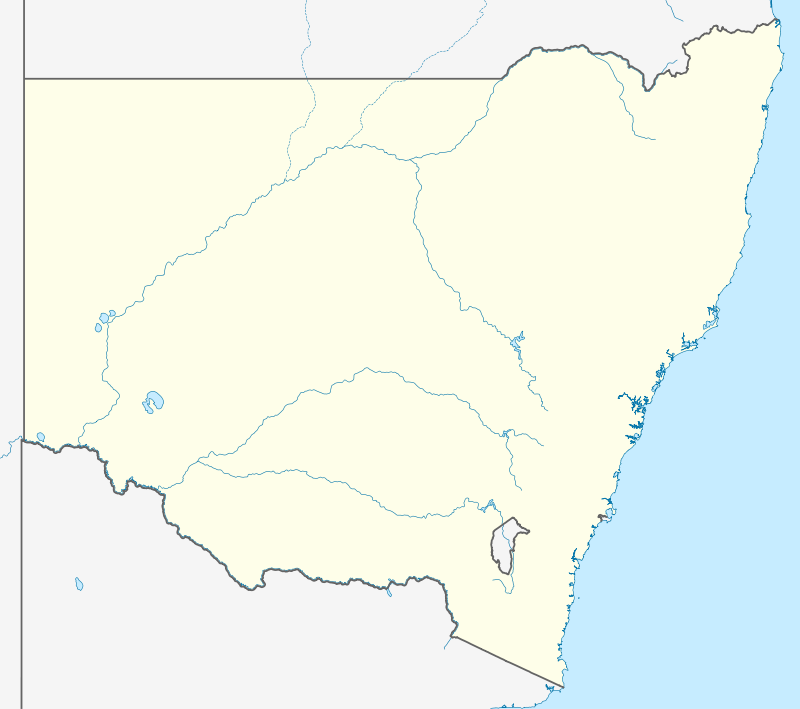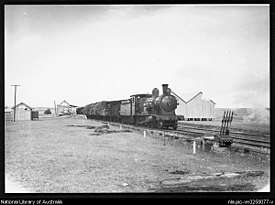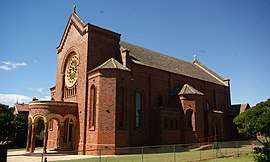Taralga
Taralga is a small village in the Southern Tablelands of New South Wales, Australia in Upper Lachlan Shire. It is located at the intersection of the Goulburn-Oberon Road and the Laggan-Taralga Road. It is accessible from Oberon to the north, Mittagong to the east, Goulburn to the south, and Crookwell to the west. At the 2016 census, Taralga had a population of 467.[1] The exact origin of the name Taralga is disputed. The two most widely supported theories are that the village was originally known as "Trial Gang" as within the early colonial boundaries of Argyle County, it was a location for the trials of convicts and bushrangers before the Crown. The second theory is that Taralga means "native companion" in the language of the Burra Aboriginal people.[2] Taralga is located relatively close to the famous Wombeyan Caves. The town experiences a volatile climate and is frequently affected by snow in the winter months.
| Taralga New South Wales | |||||||||||||||
|---|---|---|---|---|---|---|---|---|---|---|---|---|---|---|---|
 A basalt house after snowfall | |||||||||||||||
 Taralga | |||||||||||||||
| Coordinates | 34°23′0″S 149°49′0″E | ||||||||||||||
| Population | 467 (2016 census)[1] | ||||||||||||||
| Postcode(s) | 2580 | ||||||||||||||
| Elevation | 845 m (2,772 ft) | ||||||||||||||
| Location | |||||||||||||||
| LGA(s) | Upper Lachlan Shire | ||||||||||||||
| County | Argyle | ||||||||||||||
| Parish | Guineacor | ||||||||||||||
| State electorate(s) | Goulburn | ||||||||||||||
| Federal Division(s) | Hume | ||||||||||||||
| |||||||||||||||
| |||||||||||||||
The population of Taralga has fluctuated over time reflecting the town's fortunes. There were approximately 100 residents in 1863, growing to over 700 by the 1890s. Immediately after the depression of the 1890s, the population shrank to half this size, but recovered by the mid 1950s almost to its peak level. Today the town and surrounds service around 400 people.[2]
History
The area around Taralga was the traditional land of the Burra Burra peoples, a warlike tribe who often clashed with neighbouring tribes and never lost a fight. Although no major clashes with the Europeans seem to have been recorded, nor tales of collaboration with them, their last great gathering or corroboree seems to have been in the 1830s after which they are not recorded by European history. Accordingly, they would have been pushed further west to less fertile plains after the disease brought by the Europeans.
Charles Throsby passed through the Taralga area in 1819 on a journey from Cowpastures to Bathurst in search of new grazing lands. By 1824, John Macarthur's son James and his nephew Hannibal had established themselves in the Taralga region where they helped pioneer Australia's wool industry. A private village was established on land donated by James Macarthur and cleared by convicts in order to house and service members of the Macarthur family and their employees.[3] Orchard Street, now the main thoroughfare is located on the site of Macarthur's orchard. During the town's early history, Macarthur Street functioned as the main street and many examples of heritage buildings still stand here.
An 1828 census revealed a small number of residents at Taralga suggesting the village was already under way by that time, although there were probably no more than a few buildings.[4] For the first few decades of the colony of New South Wales, most of the settlers were convicts assigned to the landowners and it was they who largely cleared the land, built the huts and houses, and ran the farms. Taralga started to look like a town after the first few houses were built in the 1840s, but more rapid growth would be experienced in the 1860s in part due to the Robertson Land Acts allowing freehold title over land to settlers at favourable rates.[5]
Taralga was officially established as a town in the 1860s, with a school in 1857, and churches—Presbyterian in 1861, St. Ignatius Roman Catholic in 1864, St. Lukes Anglican in 1866 and Methodist (now the Historical Society building) in 1868. There were a number of stores, smiths and artisans' businesses and two hotels recorded in 1866. There was a large increase in population in Taralga after the 1860s, caused mainly by the gold rush bringing new migrants to the area.

In 1923, the town was visited by Premier Sir George Fuller, marking a period of renewed interest and prosperity in Taralga. During this visit, the Premier unveiled a war memorial honouring those residents who served in World War I, turned the first sod for construction of a railway link as well as laying the foundation stone for the Taralga Co-Operative Dairy Company's new butter factory.[6] The 25 km (16 mi) Taralga railway line, constructed as a branch from the Crookwell line at Roslyn opened in 1926 and closed in 1957. The line has since been lifted and little remains of the formation.[7] Electricity was first provided in the 1930s by way of a plant set up by local Mr Sid Holt.[2]
Heritage listings
Taralga has a number of heritage-listed sites, including:
- Macarthur Street: Catholic Church of Christ the King[8]
Taralga today

While the population of Taralga declined after the gold rush period, the character of the town did not. Today there are many historically significant buildings to be observed throughout the town. Small vineyards are located around the town. There are two heritage listed hotels, and a sports club with lawn bowling greens and tennis courts. There is a 9-hole golf course with sand greens. The town also hosts the annual "Australia Day Rodeo" and the Taralga Tigers Rugby Club always attracts big crowds during the Winter months and in the summer touch football is played.
The town is situated on the Goulburn-Oberon Road, designated Main Road 256 which was progressively upgraded between 2002 and 2008. Taralga is the largest settlement between the two towns and a convenient stop for travellers between Goulburn and Bathurst wishing to bypass Sydney. The town can also be accessed by rural roads from Crookwell and Marulan.
Taralga Wind Farm
On 20 February 2012, approval was granted by the New South Wales Government for work to commence on the Taralga Wind Farm. The project will see the construction of 51 wind turbines generating 106.8 Megawatts of electricity on ridges to the east of Taralga. Electricity generated by the project will be fed into the national power grid through a 38 km transmission line to Marulan Substation. The project is expected to create up to 200 local jobs during the construction phase.[9] Approval of the wind farm followed an unsuccessful challenge by the Taralga Landscape Guardians in the Land and Environment Court of New South Wales to block the project on the grounds of aesthetic and environmental impacts including noise emissions and blighting of the landscape. Chief Justice Brian Preston ruled in favour of approving the wind farm as the long term benefit of reduced greenhouse gas emissions was in the greater public interest.[10] As of 6 February 2015, 30 turbines have been erected on site, and all are turning while in their commissioning phase. The end of construction is expected to happen around June, with the Operational period to follow soon thereafter, once AEMO testing is completed. The layout of the wind farm can be seen through this link
Climate
Taralga has an oceanic climate. Temperatures are warm in summer, whereas winters are cool during days and with frequent air frosts by nightfall. Precipitation is relatively frequent year-round, peaking in winter and spring with a notable quantity of snowfall and sleet. Summer minima can occasionally be cold due to high diurnal temperature variation, as well as lack of strong winds or cloud—unlike winter, in which cloud and strong winds are frequent.
The lowest maximum temperature was 1.1 °C (34.0 °F) recorded in August 1962; the warmest maximum temperature recorded was 40.5 °C (104.9 °F) in January 2020. The coldest low plummeted to −9.6 °C (14.7 °F) in July 1982; the warmest low on record was 24.2 °C (75.6 °F) in February 1973.[11]
| Climate data for Taralga, NSW (Taralga Post Office); 845 m AMSL; 34° 24′ 17.28″ S | |||||||||||||
|---|---|---|---|---|---|---|---|---|---|---|---|---|---|
| Month | Jan | Feb | Mar | Apr | May | Jun | Jul | Aug | Sep | Oct | Nov | Dec | Year |
| Record high °C (°F) | 40.5 (104.9) |
40.2 (104.4) |
36.3 (97.3) |
31.0 (87.8) |
25.7 (78.3) |
21.5 (70.7) |
19.3 (66.7) |
22.4 (72.3) |
27.5 (81.5) |
30.5 (86.9) |
38.5 (101.3) |
39.5 (103.1) |
40.5 (104.9) |
| Average high °C (°F) | 26.3 (79.3) |
25.0 (77.0) |
22.5 (72.5) |
18.8 (65.8) |
14.5 (58.1) |
11.2 (52.2) |
10.4 (50.7) |
11.9 (53.4) |
15.0 (59.0) |
18.5 (65.3) |
21.6 (70.9) |
24.6 (76.3) |
18.4 (65.1) |
| Average low °C (°F) | 12.1 (53.8) |
12.1 (53.8) |
9.9 (49.8) |
6.2 (43.2) |
3.2 (37.8) |
1.7 (35.1) |
0.6 (33.1) |
1.2 (34.2) |
3.1 (37.6) |
5.4 (41.7) |
7.7 (45.9) |
9.9 (49.8) |
6.1 (43.0) |
| Record low °C (°F) | 1.1 (34.0) |
1.2 (34.2) |
−1.1 (30.0) |
−4.0 (24.8) |
−6.5 (20.3) |
−7.8 (18.0) |
−9.6 (14.7) |
−7.3 (18.9) |
−6.0 (21.2) |
−4.8 (23.4) |
−2.5 (27.5) |
−0.2 (31.6) |
−9.6 (14.7) |
| Average precipitation mm (inches) | 72.3 (2.85) |
72.4 (2.85) |
67.1 (2.64) |
58.1 (2.29) |
58.5 (2.30) |
76.0 (2.99) |
66.0 (2.60) |
67.2 (2.65) |
61.4 (2.42) |
69.1 (2.72) |
67.7 (2.67) |
66.2 (2.61) |
801.4 (31.55) |
| Average precipitation days (≥ 0.2 mm) | 9.2 | 9.2 | 9.3 | 8.6 | 9.7 | 12.4 | 12.1 | 11.3 | 10.1 | 9.8 | 9.1 | 8.8 | 119.6 |
| Source: Bureau of Meteorology [11] | |||||||||||||
Gallery
.jpg) Taralga c1900
Taralga c1900- Taralga Church
 Taralga Catholic Church
Taralga Catholic Church- Taralga Main Street
- Taralga Main Street
References
- Australian Bureau of Statistics (27 June 2017). "Taralga (State Suburb)". 2016 Census QuickStats. Retrieved 7 July 2017.

- "A Snapshot of Taralga's History". Upper Lachlan Shire Council. Retrieved 20 January 2013.
- Heydon, J D. "Macarthur, James (1798 - 1867)". Australian Dictionary of Biography. Australian National University. Retrieved 21 February 2007.
- "Mulwaree Shire Community Heritage Study, 2002 - 2004" (PDF). Goulburn Mulwaree Council. Archived from the original (pdf) on 19 September 2006. Retrieved 5 February 2007.
- "Taralga". Towns and Villages of the Southern Tablelands NSW. Retrieved 20 January 2013.
- "Taralga War Memorial". War Memorials in Australia. Retrieved 20 January 2013.
- Bozier, Rolfe; et al. "Taralga Line". NSWrail.net. Retrieved 5 May 2007.
- "Catholic Church of Christ the King". New South Wales State Heritage Register. Office of Environment and Heritage. H01696. Retrieved 18 May 2018.
- "Taralga Wind Farm". Renewable Energy Systems Ltd. Retrieved 20 January 2013.
- Peel, Jacqueline. "Taralga Landscape Guardians case (2007)". University of Melbourne. Retrieved 20 January 2013.
- "Climate statistics for Taralga". Bureau of Meteorology. Retrieved 24 April 2020.
External links
![]()